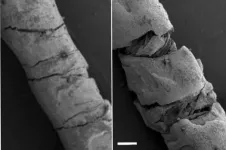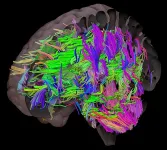(Press-News.org) Scientists have broadened our understanding of how 'weak' cells bond with their more mature cellular counterparts to boost the body's production of insulin, improving our knowledge of the processes leading to type 2 diabetes - a significant global health problem.
Type 2 diabetes mellitus occurs when β-cells cannot release enough insulin - a tightly controlled process requiring hundreds of such cells clustered together to co-ordinate their response to signals from food, such as sugar, fat and gut hormones.
An international research team - led by scientists at the University of Birmingham - have discovered that immature β-cells (PDX1LOW/MAFALOW) are able to overcome their relative deficiencies by partnering with 'stronger' counterparts to drive insulin release.
Publishing their findings today in Nature Communications, the researchers reveal that subtle differences in the levels of PDX1 and MAFA proteins (found only in β-cells) , and more broadly, differences in β-cell maturity, contribute to how clusters of insulin-producing cells, known as islets, function.
The corresponding author David Hodson, Professor of Cellular Metabolism, at the University of Birmingham, commented: "Our research shows that differences in β-cell maturity, defined using PDX1 and MAFA levels, are needed across the islet for proper insulin release. Unexpectedly, increases in the proportion of mature β-cells, is associated with islet failure. It seems that, rather like society, the islet needs cells with all ages to be properly functional.
"Redressing the balance between immature and mature β-cells restores islet function under conditions of metabolic stress - an excess of sugar and fat in the diet - providing evidence that both 'weak' and 'strong' β-cells could contribute to proper islet function and insulin release.
"This is the first glimpse that immature cells might contribute to the regulation of insulin release across the islet. Our study indicates a promising line of investigation that could be leveraged to make islets more resilient during type 2 diabetes or when generating new islets in a 'dish' for the purpose of transplantation."
Normally, mature and immature β-cells co-exist within the adult islet and can be grouped into subpopulations according to differences in their levels of specific genes and proteins. Immature β-cells are generally considered to be poorly functional when viewed alone, as single cells.
Researchers found that islets containing proportionally more PDX1HIGH and MAFAHIGH β-cells showed defects in cell function (metabolism, ionic fluxes and insulin secretion). The team believes maintaining a mix of 'strong' and 'weak' β-cells is important for effective insulin production.
INFORMATION:
For further information, interviews or an embargoed copy of the research paper, please contact Tony Moran, International Communications Manager, University of Birmingham on +44 (0)782 783 2312 or t.moran@bham.ac.uk. Out-of-hours +44 (0) 7789 921 165.
Notes for editors
* The University of Birmingham is ranked amongst the world's top 100 institutions. Its work brings people from across the world to Birmingham, including researchers, teachers and more than 6,500 international students from over 150 countries.
* 'PDX1LOW MAFALOW β-cells contribute to islet function and insulin release' - Daniela Nasteska, Nicholas H. F. Fine, Fiona B. Ashford, Federica Cuozzo, Katrina Viloria, Gabrielle Smith, Aisha Dahir, Peter W. J. Dawson, Yu-Chiang Lai, Aimée Bastidas-Ponce, Mostafa Bakhti, Guy A. Rutter, Remi Fiancette, Rita Nano, Lorenzo Piemonti, Heiko Lickert, Qiao Zhou, Ildem Akerman and David J. Hodson is published in Nature Communications.
* Participating universities and institutions include: University of Birmingham, UK; University of Nottingham, UK; Birmingham Health Partners, UK; Helmholtz Zentrum München, Germany; German Center for Diabetes Research (DZD), Neuherberg; Technical University of Munich, Germany; Imperial College London; Nanyang Technological University, Singapore; San Raffaele Diabetes Research Institute, University of Alberta, Canada; IRCCS Ospedale, Italy; San Raffaele University, Milan, Italy; and Weill Cornell Medical College, New York, NY, USA.
Engineers at Tufts University have created and demonstrated flexible thread-based sensors that can measure movement of the neck, providing data on the direction, angle of rotation and degree of displacement of the head. The discovery raises the potential for thin, inconspicuous tatoo-like patches that could, according to the Tufts team, measure athletic performance, monitor worker or driver fatigue, assist with physical therapy, enhance virtual reality games and systems, and improve computer generated imagery in cinematography. The technology, described today in Scientific Reports, adds to a growing number of thread-based ...
Researchers from the Hubrecht Institute mapped the recovery of the heart after a heart attack with great detail. They found that heart muscle cells - also called cardiomyocytes - play an important role in the intracellular communication after a heart attack. The researchers documented their findings in a database that is accessible for scientists around the world. This brings the research field a step closer to the development of therapies for improved recovery after heart injury. The results were published in Communications Biology on the 29th of January.
In the Netherlands, an average of 95 people end up in the hospital each day ...
Efforts to understand when corals reproduce have been given a boost thanks to a new resource that gives scientists open access to more than forty years' worth of information about coral spawning.
Led by researchers at Newcastle University, UK, and James Cook University, Australia, the Coral Spawning Database (CSD) for the first time collates vital information about the timing and geographical variation of coral spawning. This was a huge international effort that includes over 90 authors from 60 institutions in 20 countries.
The data can be used by scientists and conservationists to better understand the environmental cues that influence when coral ...
(Singapore--16:45 p.m. SPT/3:45 EST January 29, 2021)--Two presentations from the ADAURA clinical trial advanced previous research that demonstrated improved disease-fee survival (DFS) outcomes for patients with surgically resected non-small cell lung cancer (NSCLC) receiving osimertinib. The data were reported today at the International Association for the Study of Lung Cancer's 2020 World Conference on Lung Cancer (WCLC) Singapore.
Osimertinib is a third-generation, irreversible, central nervous system-active, epidermal growth factor receptor (EGFR)-tyrosine kinase inhibitor. ADAURA is a randomized Phase III trial comparing adjuvant osimertinib with placebo in patients ...
Beyond the ski slopes, one of the most iconic symbols of the Alps are the alpine flowers. These plants are not only beautiful -- they are also used in liqueurs and medicines, and they form the foundation of the local food chains. But a recent study in Frontiers in Ecology and Evolution shows that, although plant diversity may initially increase with glacier retreat, many of these species may soon become endangered.
"Our results indicate that plant diversity will ultimately decrease once the glaciers disappear -- and up to 22% of the species we analyzed may locally disappear or even go extinct once the glaciers are gone," says lead author Dr Gianalberto Losapio of Stanford University in the USA. "We show that 'not all species are equal before global warming' and that there are some species ...
Methane (CH4) is the second most important greenhouse gas after carbon dioxide (CO2). Its concentration in the atmosphere has increased more than twice since the preindustrial era due to enhanced emissions from human activities. While the global warming potential of CH4 is 86 times as large as that of CO2 over 20 years, it stays in the atmosphere for about 10 years, much shorter than more than centuries of CO2. It is therefore expected that emission controlling of CH4 can benefit for relatively short time period toward the Paris Agreement target to limit the global warming well below 2 degrees.
A study by an international team, published ...
New research from the University of Sheffield has found being overweight is an additional burden on brain health and it may exacerbate Alzheimer's disease.
The pioneering multimodal neuroimaging study revealed obesity may contribute toward neural tissue vulnerability, whilst maintaining a healthy weight in mild Alzheimer's disease dementia could help to preserve brain structure.
The findings, published in The Journal of Alzheimer's Disease Reports, also highlight the impact being overweight in mid-life could have on brain health in older age.
Lead author of the study, Professor Annalena Venneri from the University of Sheffield's Neuroscience Institute and NIHR Sheffield Biomedical Research Centre, ...
Four million UK patients could benefit annually from genetic testing before being prescribed common medicines, according to new research from the University of East Anglia (UEA) in collaboration with Boots UK and Leiden University (Netherlands).
Researchers looked through 2019 NHS dispensing data across the UK to see how many patients are started on new prescriptions each year that could be potentially optimised by genetic testing.
They studied 56 medicines, including antidepressants, antibiotics, stomach ulcer treatments and painkillers where there are known drug-gene interactions.
And they found that in more than one in five occasions (21.1 ...
An interdisciplinary team of the Institut national de la recherche scientifique (INRS) used an innovative imaging technique for a better understanding of motor deficits in Amyotrophic Lateral Sclerosis (ALS). The researchers were able to follow the escape behaviour of normal and disease zebrafish models, in 3D. Their results have recently been published in Optica, the flagship journal of the Optical Society (OSA).
Professor Jinyang Liang, expert in ultra-fast imaging and biophotonics, joined an effort with Professor Kessen Patten, specialist in genetics and neurodegenerative diseases. The two groups were able to track the position of ...
New research from the University of Iowa and University Hospitals Cleveland Medical Center demonstrates that offspring can be protected from the effects of prenatal stress by administering a neuroprotective compound during pregnancy.
Working in a mouse model, Rachel Schroeder, a student in the UI Interdisciplinary Graduate Program in Neuroscience, drew a connection between the work of her two mentors, Hanna Stevens, MD, PhD, UI associate professor of psychiatry and Ida P. Haller Chair of Child and Adolescent Psychiatry, and Andrew A. Pieper, MD, PhD, a former UI faculty member, now Morley-Mather Chair of Neuropsychiatry at Case Western Reserve ...






